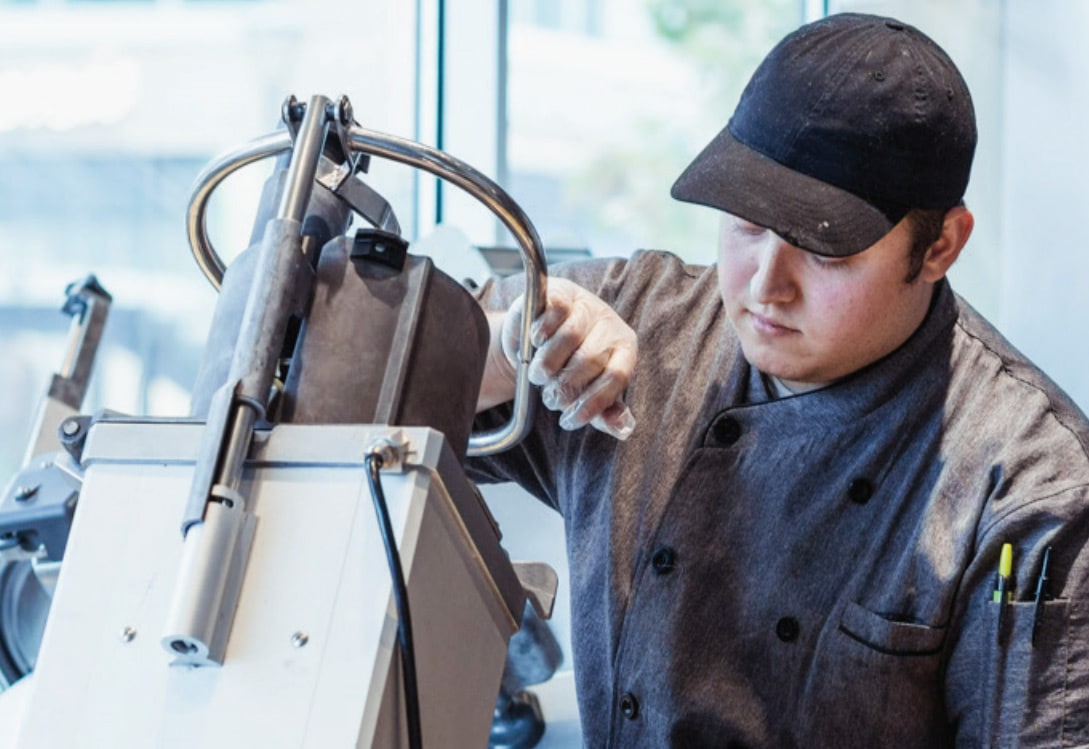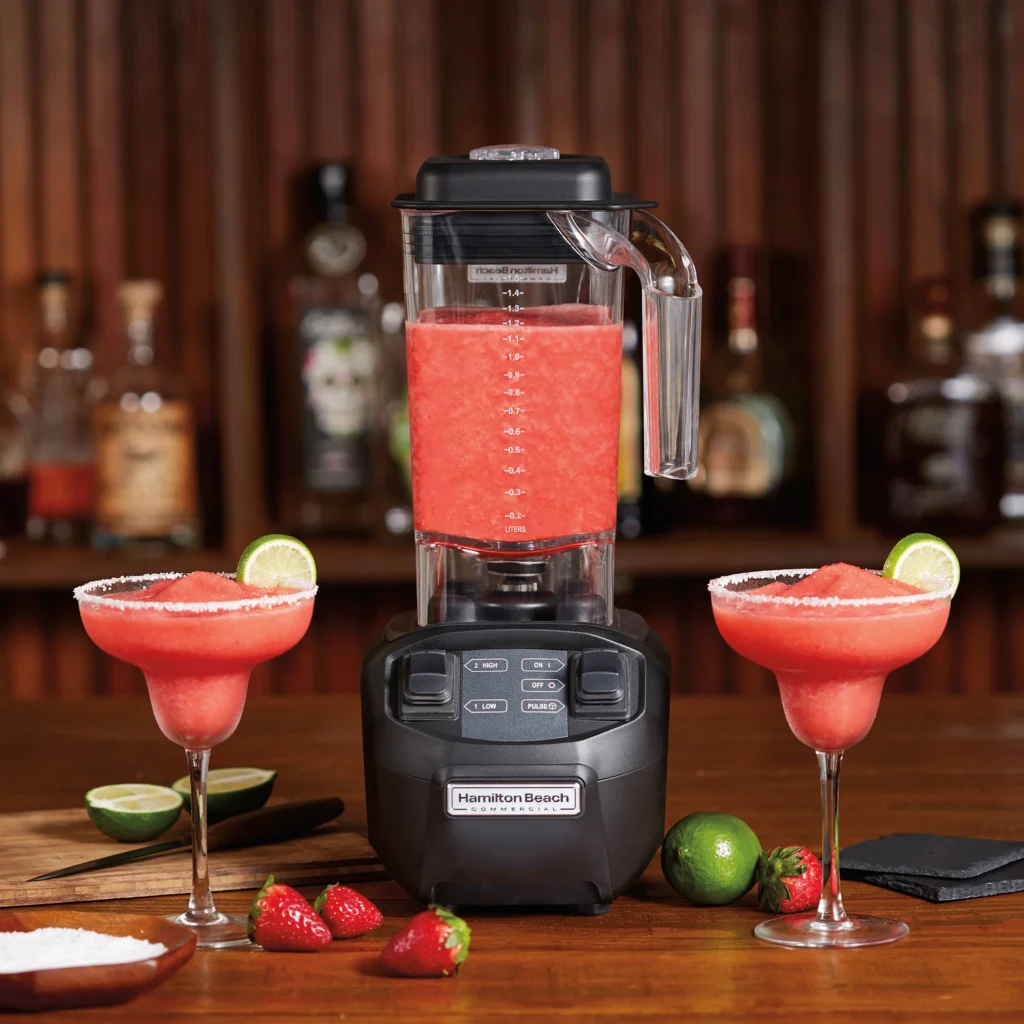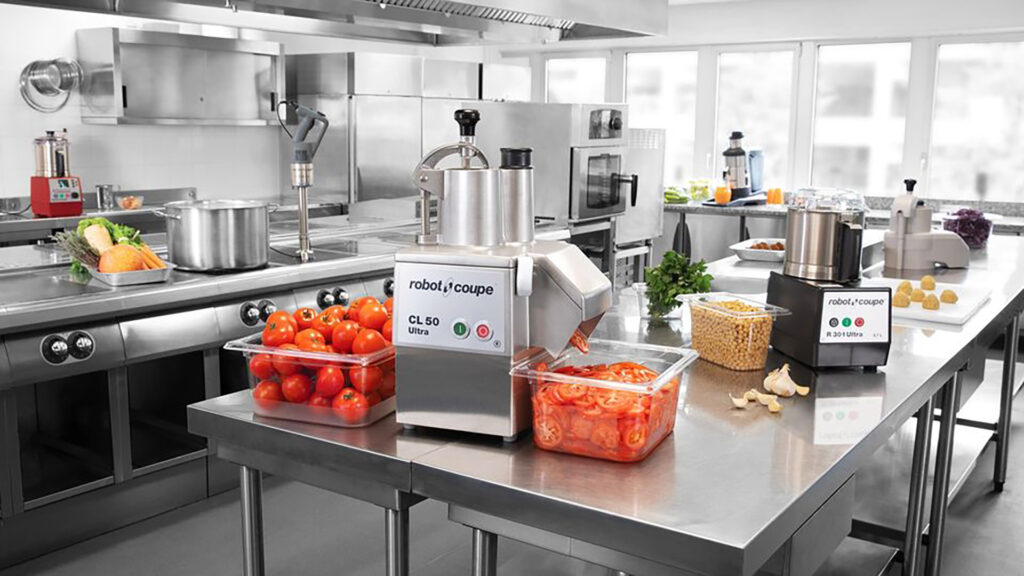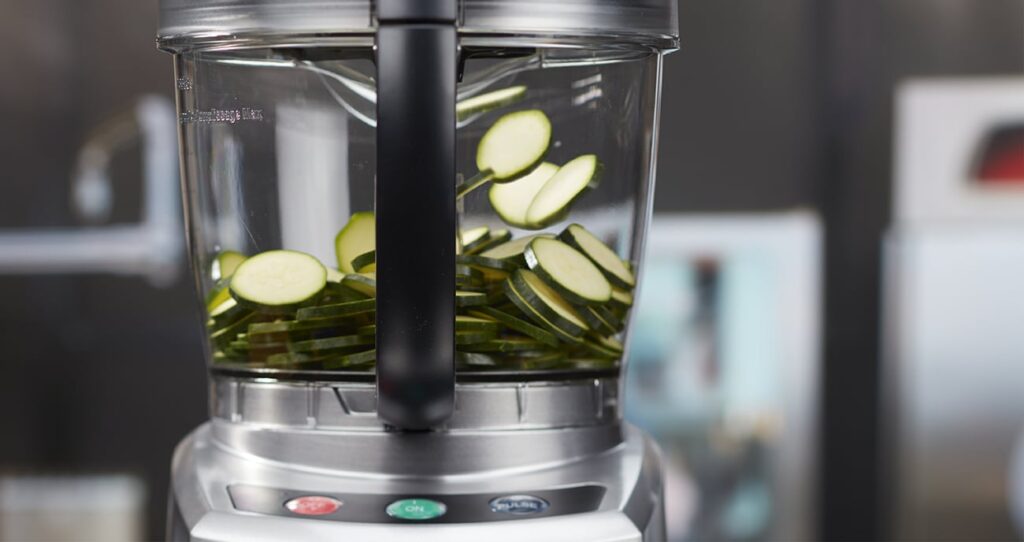Food Processor Types: Uses, Components & Buying Guide

What is a Food Processor?
Food processors, or food choppers, are kitchen appliances that do precisely what the name implies: process and chop food. These incredible, versatile machines utilize a motor to spin blades that chop, slice, grind, grate, dice, mix, and even puree everything from fruits and veggies to meats and pastry doughs.
Industrial or commercial food processors are indispensable in any commercial kitchen where chefs must chop and process large volumes of ingredients daily. Saving time and maximizing the efficiency of your kitchen line’s prep work means that your chefs can focus on what they do best: cooking quality food.
Processor Components
Motors
The motor in a food process is used to spin the cutting blades. If you process large quantities of tough and fibrous raw produce, you will want to ensure your motor has enough torque to handle it. If it doesn’t, you risk burning the motor and facing costly repairs or replacements. Countertop food processing units generally have a processing power of around 450 watts, or 0.5 mechanical horsepower, while some industrial food processor types can have up to 2.5 horsepower.
Blades
Commercial food processors come with multiple sharp blades that you can change out readily depending on the job. Here are some common blade types:
Sabatier blade: this standard S-shaped blade is the go-to workhorse of your kitchen’s food preparation process. It mixes and chops with the pulse function or blends and purees if left to spin continuously. This blade can mix pastry, pizza dough, and even grind nut butters.
Slicing disc: This blade can be handy if you want consistent and thinly sliced vegetables or meats. Think of it almost like an automatic mandoline. These discs come in various thicknesses to handle whatever slicing preparation you need.
Shredding disc: similar to a vegetable peeler, this blade produces thin shoestring-like shreds of cheese, carrots, radishes, potatoes, zucchini, or anything else you like. The shredding discs come in different sizes and shapes to handle everything from large shreds to finely grated parmesan cheese.
Dough blade: the shape of this blade is perfect for kneading pasta or bread dough.
Other differently shaped and specialty discs can also handle finesse cuts like julienne, waffle cuts, ripple cuts, brunoise, and french fry cuts. Depending on the cooking goals of your kitchen, you may want to explore a machine that offers some of these unique options.
Blenders vs. Food Processors
You may think, “Can’t I just use a blender to puree and mix sauces, spreads, and soups?” Well, sometimes. Blenders, especially high-power commercial ones like the Waring CB15VSF can do many things that a good food processor can do. They can both be used to puree and blend large volumes of soups, spreads, and salad dressings. But there are some key differences:

Blenders:
- Have a taller container vessel with a pouring spout.
- Will yield a more liquid/fine puree with smooth results.
- Can produce emulsified and creamy textures, aiolis, coulis, and aerated soups that are silky, even without dairy.
- Grind granulated sugar into powdered sugar, blend creamy puddings, froth milk, and crush ice!

Food processors:
- Will usually produce coarser blends like salsas.
- Are better for chopping/slicing/mixing bulky, hard, or raw produce.
- Have shorter, wider vessels to accommodate the bulk of whole produce and larger quantities of chopped/mixed ingredients at a time.
Food Processor Types
Batch Bowl Food Processors
Batch bowl food processors are similar to the classic type used in homes. They feature a closed cylindrical reservoir to contain all the chopped, sliced, or processed ingredients. When the processing is finished, the whole bowl lifts off the machine’s base for easy transfer into a larger work bowl and easy cleanup!
The ingredients processed in a batch bowl food processor stay in the reservoir until the machine is turned off. This design allows you to continue processing small portions of ingredients for any time you need. The longer you let the ingredients process in the reservoir, the finer they will be chopped, the more they will be kneaded, or the smoother the puree will become. The versatility of this food processor type gives you the greatest degree of control over how your ingredients are handled.
When purchasing a batch bowl food processor, you must consider reservoir capacity, blade rotation speed, motor power, discs, attachments, brand, and price. Many large commercial batch bowl food processors can hold up to 16 cups, or one gallon of food at any time. If you plan on processing multiple gallons of food every single day, you’ll want to ensure that the motor can keep up, that the rotation speed is adequate to meet your processing needs, and that the included attachments will get all of your jobs done.
Continuous Feed Food Processors
Continuous feed food processor types are designed for ease of use. They trade the cylindrical food bowl for a reservoir with an exit spout. As you feed ingredients into the machine, they are processed through the blade and then ejected via the spout into another container you place underneath. This design allows you to work through considerably more than one gallon of ingredients without ever having to stop and empty the reservoir.
Continuous feed models are best used for chopping, slicing, dicing, shredding, and grinding. Because the feed tube, bowl, and exit spout are fixed and not detachable, they can house the most powerful motors and sharpest blades. These commercial food processors are the best choice if you are looking for durability.
There is a considerable variety of continuous feed food processor types. Some are large floor-standing units large enough to process whole heads of cabbage within a second or two. Some even come with racks to hold multiple catch bins for continual usage. On the other end, smaller countertop units dispense ingredients into a separate container that you remove and replace as you go.
Combination Food Processors
Combination Food Processors are a mix of the other two types. They come with the ability to switch out the batch bowl for a reservoir with an exit spout, which means you get the best of both worlds without buying two different pieces of expensive commercial equipment.
If your commercial kitchen heavily processes small batches of ingredients on the fly but also processes large quantities of raw food items during food preparation, then a combination food processor might be the best choice for you.
Since you’ll be using both styles of food processing abilities, you’ll probably want to select the highest rotation speed and most powerful motor you can. That way, you don’t risk burning the motor out with all the prep work you’ll be giving it.
Factors to Consider When Buying a Food Processor

Capacity and Size
The capacity and size you need for your food processor will depend on how you plan to use it. For a batch bowl type, consider how many batches of dough, sauce, or chopped vegetables you need to make daily and how quickly you need to make them to determine the capacity you’ll need. You also want to think about the size of the feed chute. The larger the chute is, the less you have to pre-chop your ingredients before feeding them into the machine.
Ask yourself: will a 16-cup food processor be enough for my kitchen’s meal prep? If not, then a batch bowl design isn’t the right food processor for you.
If you’re looking for a continuous feed unit, consider whether you have enough floor space for a large machine or if a countertop food processor will meet your needs. If you have multiple line stations that could use a food processor for meal prep or service, then a countertop continuous feed or combination model is a great food processor for you.
Power and Motor Strength
Don’t be overwhelmed by the enormous variety of motors, speeds, and power. If your kitchen runs through hundreds of pounds of ingredients daily, consider a higher-power food processor like the Hobart FP350-1B Continuous Feed Food Processor. A model like this boasts a 420-rotation speed and one mechanical horsepower, enough to process up to 26 pounds of ingredients per minute!
On the other hand, if you are looking for assistance chopping softer vegetables or making spreads/sauces, you may not need to go that high. A model like the Hobart FP150-1A Full Moon PusherContinuous Feed Food Processor with 3 Discs, which operates with ½ horsepower while maintaining the 420 rpm, might be enough to cover your bases.
Accessories and Attachments
In addition to the wide variety of discs you can use in your food processor, there are accessories and attachments you can buy that will help you accomplish even more during your meal prep. There are whisking attachments, juicers, citrus presses, dough hooks, blender attachments, and more. And, of course, there are lids you can buy for your batch bowl for easy food storage.
Safety Features
The most important thing to remember regarding safety is that you must manually load food into your food processor. Therefore, you should look for safety features that help protect your staff from getting their fingers anywhere near the blades. Countertop models with a feed chute usually have a pusher that helps push food against the blade. Most continuous feed models have guards to prevent the user from reaching toward the blade for clogs if they occur.
Mechanically, commercial food processors usually have emergency stops, failsafe kill switches, and safety grates to ensure that you can cut the power if something goes wrong or if anything enters the machine that shouldn’t be there.
Maintenance and Care Tips for Food Processors
Properly cleaning and maintaining your commercial food processor is paramount for food safety.
- Batch bowl models are the easiest to clean since the bowls, chutes, and blades can all be removed with simple lock-and-click mechanisms.
- Continuous feed models must be fully disassembled for cleaning, which can be much more difficult.
Food processor parts, including the base, should always be thoroughly cleaned and dried before reassembling. This decreases the risk of rust, mold, or bacterial growth in the attachment mechanisms.
Never feed hard items like pits, silverware, or plastic into the feed chute. You don’t want them jamming the blades or shooting out of the exit spout.
The Bottom Line
There are many different types of food processors to choose from. Before you begin your search, make a list of your commonly used ingredients and what volume of work your new appliance will need to handle so that you have a good idea of the size, capacity, design, and power you will need. Always remember, it’s better to be safe than sorry. While very powerful commercial food processors may come at a high price, know that finding a good food processor is a long-term investment in your restaurant. Buying better equipment means you won’t have to worry about expensive and inconvenient repairs and your team won’t smell burning from an overtaxed motor. This is why Eleven36 carries the best and most reliable equipment on the market. If your commercial food processor can easily handle anything you throw at it, you’ve set yourself and your business up for success!
